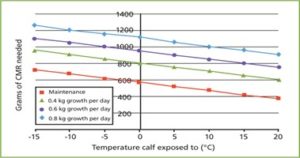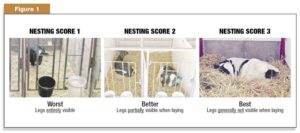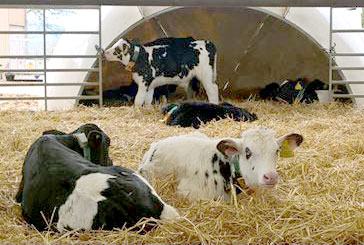Are Your Calves Prepared for Winter?
13 November 2020Now is the time to consider the thermal comfort of your dairy calves as the winter months approach. The effect of cold on calf health, growth rates and future production should not be underestimated. Winter born calves have been shown to produce less milk in their first lactation compared to summer born calves, the difference quantified as 545kg less by Cornell University.
A dairy calf under three weeks of age has a lower critical temperature of between 10-15˚C, depending on the airspeed in the shed. Not only are there increased energy demands for maintenance and growth, susceptibility to disease can also be increased under colder conditions. The following measures can be taken to help combat the effects of cold on young calves:
Whole Milk/Calf Milk Replacer Intake
Increase milk or calf milk replacer (CMR) intake, either by feeding more or increasing concentration of powder from 12.5% to 15% inclusion. A rule of thumb is to provide an extra 0.33 litres of whole milk or an extra 50g of CMR for every 5˚C drop below 15˚C.
The following graph shows the requirement in g/day of CMR to achieve different weight gains depending on temperature. At 20˚C, 900g of CMR should achieve 0.8kg/day. At 5˚C, calves require nearly 1.1kg CMR to achieve the same growth rate.
Milk replacer (20ME MJ/kg DM) required to support different growth rates in a 45kg calf under three weeks of age
Source: Cooper and Watson, 2013
Milk Intake Build Up
Consider how quickly calves are built up to their full allocation of milk. It is not unusual for calves to take at least a week to regain birth weight due to underfeeding of energy, especially during colder conditions. In bucket fed systems, two litres of milk twice a day in the first week of life is insufficient for Holstein-Friesian or similar sized calves and a minimum of 2.5 litres per feed should be given, with the aim of increasing up to 3 litre feeds after the first week to increase energy intake, growth performance and strengthen immunity.
Bedding
Is bedding provision adequate? In theory, calves should be bedded as if it costs you nothing! If calves can nest in deep bedding, this insulation helps reduce heat loss and less energy from fat reserves is required to maintain body temperature, with more energy available to support the immune system. Nesting has been shown to reduce the incidence of respiratory disease.
Source: https://www.progressivedairy.com/topics/calves-heifers/optimizing-respiratory-health-in-calf-barns
Calf Jackets
Jackets are a great way to keep calves warm, with those under one month of age benefiting the most. Tips for using calf jackets are as follows:
- Ensure coats are completely dry before fitting a jacket.
- Look out for straps rubbing and adjust for growth as calves get bigger.
- Disinfect jackets between calves with a licensed product for cryptosporidium, then wash at 60˚C to kill cryptosporidium eggs.
- If jackets become wet, change them so the calf does not chill. Make sure calves are not sweating under their jackets, which can lead to chilling at night-time. Remove during the day if sweating, then replace at night.
- Remove jackets in the morning and not later in the day.
Ventilation
Although fresh air is important, the calf shed must be free from draughts and a windspeed of only 5mph can drop the effective temperature by 8˚C. As calves do not produce enough heat to drive the stack effect, mechanical ventilation should be considered if ventilation is poor and building modifications are not possible to increase the air inlet and outlet areas. Assessed ventilation with the use of smoke pellets. The smoke should rise and clear within two minutes on a still day. Consider creating sheltered areas for young calves in draughty buildings with straw bales and sheeting on top to help reduce the impact of draughts at calf level.
Monitoring calf growth rates can help to assess whether colder weather is impacting on performance, with the aim of achieving a daily liveweight gain of between 0.7 to 0.8kg/day and doubling calf birth weight at weaning (at 8 weeks).
Reference:
Cooper, R and Watson, I. 2013. A guide to feeding and assessment of milk replacer. Livestock, November/December 2013, Vol 18 No 6
Lorna MacPherson, lorna.macpherson@sac.co.uk
Sign up to the FAS newsletter
Receive updates on news, events and publications from Scotland’s Farm Advisory Service



